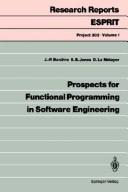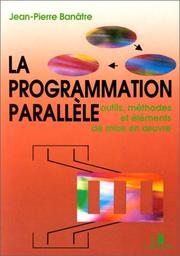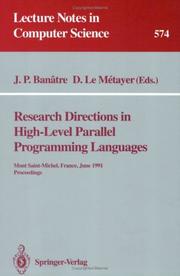| Listing 1 - 10 of 18 | << page >> |
Sort by
|

ISBN: 3540538526 0387538526 9783540538523 Year: 1991 Volume: 1 Publisher: Berlin : Springer-Verlag,
Abstract | Keywords | Export | Availability | Bookmark
 Loading...
Loading...Choose an application
- Reference Manager
- EndNote
- RefWorks (Direct export to RefWorks)

ISBN: 9782212082418 221208241X Year: 1991 Publisher: Paris: Eyrolles,
Abstract | Keywords | Export | Availability | Bookmark
 Loading...
Loading...Choose an application
- Reference Manager
- EndNote
- RefWorks (Direct export to RefWorks)
Book
Year: 1992 Publisher: New York, New York : Association for Computing Machinery,
Abstract | Keywords | Export | Availability | Bookmark
 Loading...
Loading...Choose an application
- Reference Manager
- EndNote
- RefWorks (Direct export to RefWorks)
A significant body of experience in the design and implementation of distributed operating systems has been developed in the last 15 years, both through research prototypes and industrial products. It seemed that it was time to attempt to formulate, to consolidate and to evaluate the main models, concepts and paradigms on which the design of distributed operating systems is based.The papers in this volume were selected for the 1992 ACM SIGOPS European Workshop dealing with models and paradigms for distributed systems structuring. Papers were selected by the program committee from a collection of 76 position papers submitted in response to a call for participation.The principal selection criteria were technical contribution, originality and relevance to major research tracks in Distributed Operating Systems.
Book
Abstract | Keywords | Export | Availability | Bookmark
 Loading...
Loading...Choose an application
- Reference Manager
- EndNote
- RefWorks (Direct export to RefWorks)
Nowadays, developers have to face the proliferation of hardware and software environments, the increasing demands of the users, the growing number of p- grams and the sharing of information, competences and services thanks to the generalization of databases and communication networks. A program is no more a monolithic entity conceived, produced and finalized before being used. A program is now seen as an open and adaptive frame, which, for example, can - namically incorporate services not foreseen by the initial designer. These new needs call for new control structures and program interactions. Unconventional approaches to programming have long been developed in various niches and constitute are servoir of alternative ways to face the programming languages crisis. New models of programming (e. g. , bio-inspired computing, artificial chemistry, amorphous computing,. . . )a real so currently experiencing a renewed period of growth as they face specific needs and new application - mains. These approaches provide new abstractions and notations or develop new ways of interacting with programs. They are implemented by embedding new sophisticated data structures in a classical programming model (API), by extending an existing language with new constructs (to handle concurrency, exceptions, open environments, . . . ), by conceiving new software life cycles and program executions (aspect weaving, run-time compilation) or by relying on an entire new paradigm to specify a computation. They are inspired by theoretical considerations (e. g. , topological, algebraic or logical foundations), driven by the domain at hand (domain-specific languages like PostScript, musical notation, animation, signal processing, etc. ) or by metaphors taken from various areas (quantum computing, computing with molecules, information processing in biological tissues, problem solving from nature, ethological and social modeling).
Book
ISBN: 2726101461 Year: 1977 Publisher: Le Chesnay Institut de recherche d'informatique et d'automatique
Abstract | Keywords | Export | Availability | Bookmark
 Loading...
Loading...Choose an application
- Reference Manager
- EndNote
- RefWorks (Direct export to RefWorks)
Computer algorithms --- Programming languages (Electronic computers) --- Congresses --- Semantics --- Congresses
Book
Abstract | Keywords | Export | Availability | Bookmark
 Loading...
Loading...Choose an application
- Reference Manager
- EndNote
- RefWorks (Direct export to RefWorks)
Nowadays, developers have to face the proliferation of hardware and software environments, the increasing demands of the users, the growing number of p- grams and the sharing of information, competences and services thanks to the generalization of databases and communication networks. A program is no more a monolithic entity conceived, produced and finalized before being used. A program is now seen as an open and adaptive frame, which, for example, can - namically incorporate services not foreseen by the initial designer. These new needs call for new control structures and program interactions. Unconventional approaches to programming have long been developed in various niches and constitute are servoir of alternative ways to face the programming languages crisis. New models of programming (e. g. , bio-inspired computing, artificial chemistry, amorphous computing,. . . )a real so currently experiencing a renewed period of growth as they face specific needs and new application - mains. These approaches provide new abstractions and notations or develop new ways of interacting with programs. They are implemented by embedding new sophisticated data structures in a classical programming model (API), by extending an existing language with new constructs (to handle concurrency, exceptions, open environments, . . . ), by conceiving new software life cycles and program executions (aspect weaving, run-time compilation) or by relying on an entire new paradigm to specify a computation. They are inspired by theoretical considerations (e. g. , topological, algebraic or logical foundations), driven by the domain at hand (domain-specific languages like PostScript, musical notation, animation, signal processing, etc. ) or by metaphors taken from various areas (quantum computing, computing with molecules, information processing in biological tissues, problem solving from nature, ethological and social modeling).
Book
Abstract | Keywords | Export | Availability | Bookmark
 Loading...
Loading...Choose an application
- Reference Manager
- EndNote
- RefWorks (Direct export to RefWorks)
Nowadays, developers have to face the proliferation of hardware and software environments, the increasing demands of the users, the growing number of p- grams and the sharing of information, competences and services thanks to the generalization of databases and communication networks. A program is no more a monolithic entity conceived, produced and finalized before being used. A program is now seen as an open and adaptive frame, which, for example, can - namically incorporate services not foreseen by the initial designer. These new needs call for new control structures and program interactions. Unconventional approaches to programming have long been developed in various niches and constitute are servoir of alternative ways to face the programming languages crisis. New models of programming (e. g. , bio-inspired computing, artificial chemistry, amorphous computing,. . . )a real so currently experiencing a renewed period of growth as they face specific needs and new application - mains. These approaches provide new abstractions and notations or develop new ways of interacting with programs. They are implemented by embedding new sophisticated data structures in a classical programming model (API), by extending an existing language with new constructs (to handle concurrency, exceptions, open environments, . . . ), by conceiving new software life cycles and program executions (aspect weaving, run-time compilation) or by relying on an entire new paradigm to specify a computation. They are inspired by theoretical considerations (e. g. , topological, algebraic or logical foundations), driven by the domain at hand (domain-specific languages like PostScript, musical notation, animation, signal processing, etc. ) or by metaphors taken from various areas (quantum computing, computing with molecules, information processing in biological tissues, problem solving from nature, ethological and social modeling).

ISBN: 3540551603 0387551603 3540467629 Year: 1992 Volume: vol 574 Publisher: New York, NY : Springer-Verlag,
Abstract | Keywords | Export | Availability | Bookmark
 Loading...
Loading...Choose an application
- Reference Manager
- EndNote
- RefWorks (Direct export to RefWorks)
This volume contains most of the papers presented at the workshop on research directions in high-level parallel programming languages, held at Mont Saint-Michel, France, in June 1991. The motivation for organizing this workshop came from the emergence of a new class of formalisms for describing parallel computations in the last few years. Linda, Unity, Gamma, and the Cham are the most significant representatives of this new class. Formalisms of this family promote simple but powerful language features for describing data and programs. These proposals appeared in different contexts and were applied in different domains, and the goal of the workshop was to review the status of this new field and compare experiences. The workshop was organized into four main sessions: Unity, Linda, Gamma, and Parallel Program Design. The corresponding parts ofthe volume are introduced respectively by J. Misra, D. Gelernter, D. Le M tayer, and J.-P. Ban tre.
-681.3*D13 --- Tools and techniques: decision tables flow charts modules and interfaces programmer workbench software libraries structured programming top-down programming user interfaces (Software engineering) --- language classifications: applicative languages data-flow languages design languages extensible languages macro and assembly languages nonprocedural languages specialized application and very high-level languages (Programminglanguages) --- Languages constructs: abstract data types concurrent programming structurescontrol structures coroutines (Programming languages) --- 681.3*D33 Languages constructs: abstract data types concurrent programming structurescontrol structures coroutines (Programming languages) --- 681.3*D32 language classifications: applicative languages data-flow languages design languages extensible languages macro and assembly languages nonprocedural languages specialized application and very high-level languages (Programminglanguages) --- 681.3*D22 Tools and techniques: decision tables flow charts modules and interfaces programmer workbench software libraries structured programming top-down programming user interfaces (Software engineering) --- Parallel programming (Computer science) --- 681.3*D13 --- 681.3*D22 --- 681.3*D32 --- 681.3*D33 --- 681.3*D33 Languages constructs: abstract data types; concurrent programming structures;control structures; coroutines (Programming languages) --- Languages constructs: abstract data types; concurrent programming structures;control structures; coroutines (Programming languages) --- 681.3*D32 language classifications: applicative languages; data-flow languages; design languages; extensible languages; macro and assembly languages; nonprocedural languages; specialized application and very high-level languages (Programminglanguages) --- language classifications: applicative languages; data-flow languages; design languages; extensible languages; macro and assembly languages; nonprocedural languages; specialized application and very high-level languages (Programminglanguages) --- 681.3*D22 Tools and techniques: decision tables; flow charts; modules and interfaces; programmer workbench; software libraries; structured programming; top-down programming; user interfaces (Software engineering) --- Tools and techniques: decision tables; flow charts; modules and interfaces; programmer workbench; software libraries; structured programming; top-down programming; user interfaces (Software engineering) --- 681.3*D13 Concurrent programming --- Concurrent programming --- Congresses --- Congresses. --- Parallel programming (Computer science) - Congresses. --- Computer network architectures. --- Computer science. --- Software engineering. --- Computer System Implementation. --- Programming Languages, Compilers, Interpreters. --- Programming Techniques. --- Software Engineering. --- Computer software engineering --- Engineering --- Informatics --- Science --- Architectures, Computer network --- Network architectures, Computer --- Computer architecture
Book
Year: 1986 Publisher: Le Chesnay Institut national de recherche en informatique et en automatique
Abstract | Keywords | Export | Availability | Bookmark
 Loading...
Loading...Choose an application
- Reference Manager
- EndNote
- RefWorks (Direct export to RefWorks)
Book
Year: 1986 Publisher: Le Chesnay Institut national de recherche en informatique et en automatique
Abstract | Keywords | Export | Availability | Bookmark
 Loading...
Loading...Choose an application
- Reference Manager
- EndNote
- RefWorks (Direct export to RefWorks)
| Listing 1 - 10 of 18 | << page >> |
Sort by
|

 Search
Search Feedback
Feedback About UniCat
About UniCat  Help
Help News
News